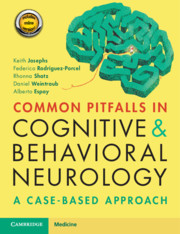Book contents
- Common Pitfalls in Cognitive and Behavioral Neurology
- Common Pitfalls in Cognitive and Behavioral Neurology
- Copyright page
- Dedication
- Contents
- Diseases Discussed in the Book
- Preface
- Acknowledgements
- Abbreviations
- Part 1 Missing the Diagnosis Altogether
- Part 2 Misidentifying the Impaired Cognitive Domain
- Part 3 Missing Important Clues in the History
- Part 4 Failure of Pattern Recognition
- Part 5 Difficult-to-Characterize Cognitive/Behavioral Disorders
- Case 21 Difficulty with Language: When Is It Not Aphasia?
- Case 22 Frontal, Parietal, or Neither?
- Case 23 Cognitive Impairment as an Unexpected Guest
- Case 24 Punch Drunk
- Case 25 Remembering without Knowing
- Part 6 Clinical Findings That Are Subtle
- Part 7 Misinterpreting Test Results
- Part 8 Attributing Findings to a Known or Suspected Disorder
- Part 9 Missing Radiographic Clues
- Part 10 Management Misadventures
- Index
- Plate Section (PDF Only)
- References
Case 21 - Difficulty with Language: When Is It Not Aphasia?
from Part 5 - Difficult-to-Characterize Cognitive/Behavioral Disorders
Published online by Cambridge University Press: 03 November 2020
- Common Pitfalls in Cognitive and Behavioral Neurology
- Common Pitfalls in Cognitive and Behavioral Neurology
- Copyright page
- Dedication
- Contents
- Diseases Discussed in the Book
- Preface
- Acknowledgements
- Abbreviations
- Part 1 Missing the Diagnosis Altogether
- Part 2 Misidentifying the Impaired Cognitive Domain
- Part 3 Missing Important Clues in the History
- Part 4 Failure of Pattern Recognition
- Part 5 Difficult-to-Characterize Cognitive/Behavioral Disorders
- Case 21 Difficulty with Language: When Is It Not Aphasia?
- Case 22 Frontal, Parietal, or Neither?
- Case 23 Cognitive Impairment as an Unexpected Guest
- Case 24 Punch Drunk
- Case 25 Remembering without Knowing
- Part 6 Clinical Findings That Are Subtle
- Part 7 Misinterpreting Test Results
- Part 8 Attributing Findings to a Known or Suspected Disorder
- Part 9 Missing Radiographic Clues
- Part 10 Management Misadventures
- Index
- Plate Section (PDF Only)
- References
Summary
A 70-year-old man had worsening speech over 18 months, with increased effort required to enunciate words. His wife described him as speaking with a monotone voice, and the overall rate of speech was slow. He paused frequently between and in the middle of words, especially during long and complex sentences. He denied problems with finding words, forming sentences, or comprehending spoken or written language. His writing mirrored the slowness in speaking, but there were no abnormalities in its appearance or spelling. On exam, his speech exhibited increased intersegment duration between words, as well as aprosodia. No sound distortions were noticed, except for one false start. Subtle agrammatism was detected early in the interview, though grammar appeared normal during the remainder of the examination (Video 21.1). The rest of his language evaluation and neurological exam was unremarkable. An MRI of the brain demonstrated asymmetric atrophy, predominantly affecting the left premotor cortex.
- Type
- Chapter
- Information
- Common Pitfalls in Cognitive and Behavioral NeurologyA Case-Based Approach, pp. 67 - 70Publisher: Cambridge University PressPrint publication year: 2020



